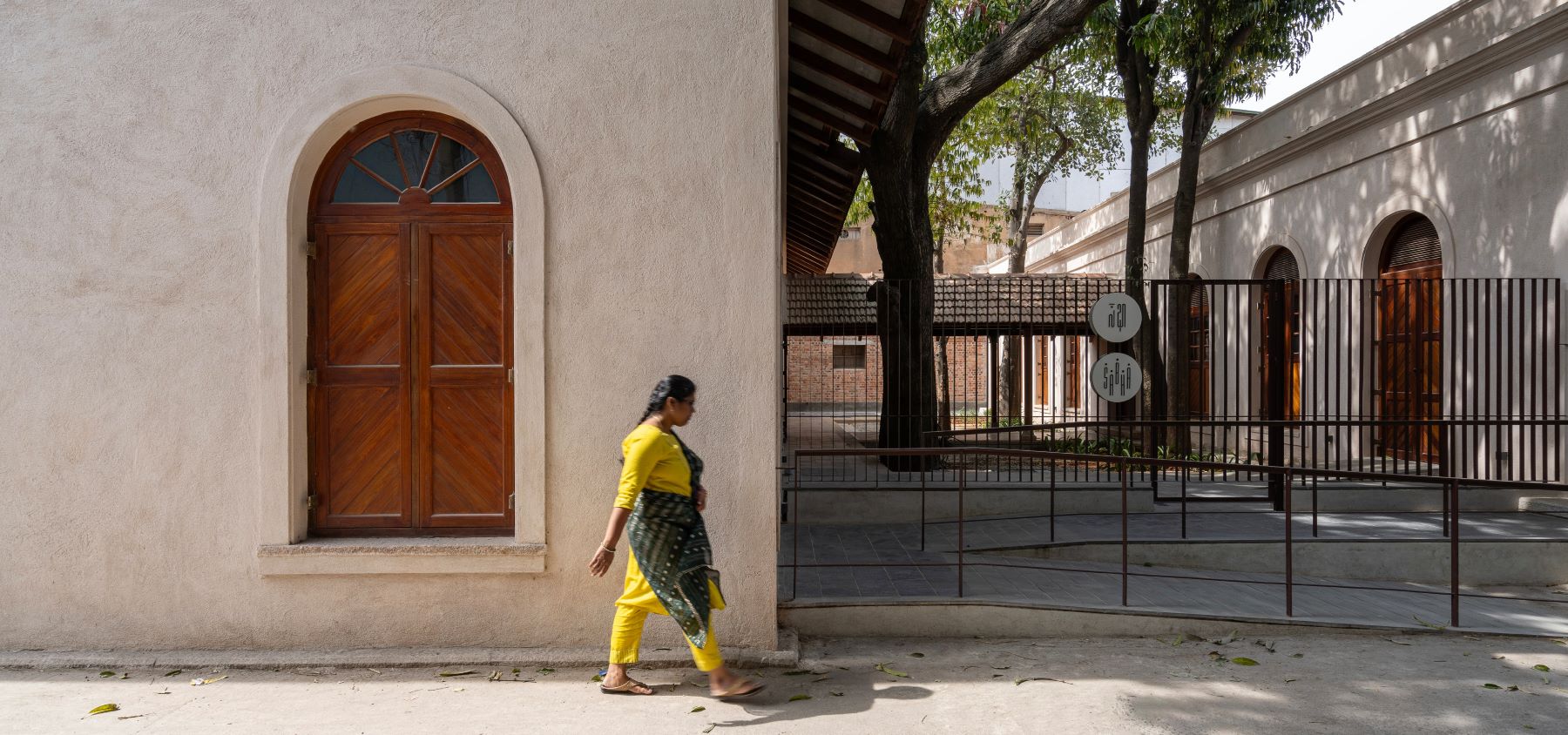Student internship is a quintessential part of an architectural education. However, it is increasingly becoming an unmitigated ordeal for many within the community. Affecting both students and practicing architects, the workforce imbalance and issues of ineptitude have created an unfavourable – and often exploitative – situation.
Inviting the opinions of architects, educators and students, we strive to start a conversation about what can be done to improve this situation. Below, Chitra Vishwanath shares her opinions about the issue.

There is a need to look at internship very seriously.
The large number of students in the country is not commensurate to the available offices. There is also a limit to the number of students that an office can take in. When such is the case, what are the responsibilities of the students as well as the schools of architecture?
Most of the times, the student selects an office to apply to, while the office selects the student on the basis of the portfolio sent in. Both of these are legitimate processes. However, this comes with its own set of problems:
Authenticity of Portfolios
There is little to no input from the institutes when it comes to verifying the subject matter of the portfolio. The office, then, must take the contents at face value. We trust that what is represented in the portfolio genuinely belongs to the said student. However, there have been instances where a student’s performance was contrary to the skills displayed in the portfolio.
Here, I question the role of the institute – shouldn’t it validate the authenticity of the work?
Hierarchy within the office
An office builds up its reputation on its design methodology, and that takes perseverance and creativity of the person/team that set up the practice. At no point in any office is an intern or a fresh graduate expected to handle a design charge. If the office does so, there is something amiss.
Most conscientious firms feel it is their responsibility to pay back to the society by providing internships. However, the purpose of internship needs to be understood by the interns as well as the offices.
The dictionary meaning of an intern is “A student or trainee who works, sometimes without pay, in order to gain work experience or satisfy requirements for a qualification”. For a student, the intention of an internship is to gain experience. Interns are thus the smallest cog in the wheel. They get the chance to learn from watching and maybe even imitating.
Most offices provide a stipend, which may or may not be equivalent to a salary. However, as mentioned before – an internship is a part of the course and therefore not a job. Further, architectural education is a long, drawn-out process and is never finished.
Ideally, the interns should apply themselves as they would as students. Einstein said – “Genius is 1% talent and 99% hard work.” and a practice expects this from the interns.
Irresponsibility of Institutes
As per the institute’s policy, practices often fill up a form for student evaluation. However, there is very little genuine communication between the institute and the practice. In fact, the institutes rarely even acknowledge the learning that the students receive from the practice.
Moreover, most offices are digitally equipped but the schools send inadequately trained interns. The office/practice is a commercial entity, not an ‘Institute’ to either teach or provide a knowledge sharing platform. They may/need not have the patience all the time to teach the basics. In this situation, it is the student who suffers. Institutes should take a serious view towards making students adept at the required digital skills.
Mindset of the Students
At this stage, it is important to learn the nuances instead of being too concerned with remuneration. When a student gets consumed with the aspect of remuneration and the “kind of work” they get, the mind gets closed to learning. In every office, something can be learnt which is of use to the student in their professional lives later.
The ideal time for internship is the 7th semester. This gives institutes the time to prepare students for internships by teaching them the necessary skills. Interns, in turn learn from real-life scenarios which they can tap into in later semesters. A student coming after the 9th semester tends to believe that he/she is already an architect. This perception colours the objective of learning and tends to make it job-oriented – which an internship is not.
My advice to students is to neither take internship lightly nor look at it as a means of commercial gain. You are at a stage in life where learning must be the primary means for self-fulfillment.
 Chitra Vishwanath is a Bengaluru-based architect who works on themes related to ecology and architecture. She is the Principal Architect and Managing Director of BIOME Environment Solutions Private Limited.
Chitra Vishwanath is a Bengaluru-based architect who works on themes related to ecology and architecture. She is the Principal Architect and Managing Director of BIOME Environment Solutions Private Limited.








21 Responses
very nicely said ma’am. Thank you for enlightening our vision towards internships. But many times the offices considers us as draftsman even if we have more capability and potential of doing work. Most of the times we are just given the work of drafting, 3d modelling, typing estimates and BOQs. In this case the offices are reverting back the same candidates with zero practical knowledge from their side even if the schools have provided them with a good calibre student. and again its the students who suffers.
I think you have a point. It is poignant indeed to reflect on the current situation. The institutes should authenticate the students work. The institutes need to be sincere in evaluating the students work; there needs to be a stage in training of interns where Architects Office give their interim reviews and have a right to continue with the intern or review and reject his/ her candidature as intern.
Charak-better to give you an insight from self experience. When I began the practice, I had to draft all the drawings myself, had to make estimates myself, and even do 3 D modelling–which then was models and sketches all by myself. Do you believe you have complete idea of estimation, BOQ, Specifications?I did not. I had to learn at the job. Isn’t it better that while you type the estimate familiarize yourself about the specs and rates?What is wrong at doing the 3d?You get the idea of how the massing is being done for example. Obviously the conceptualization is by the senior architect. It takes a lot of grit to get to a state where one has an office for oneself.Surely,no architect of character would give away the designs to an intern.This is the time to learn how an office works. It is time to learn how various people come together fro an architectural product. It certainly is no “Diva” situation for architects.It is hard work.
Most appropriate analysis of the situation.
Happy about this..
One thing I wanna tell is that, I internship is where we (the middle benchers/ B-C graded students) are been more noticed or seen as more talented/hard working than the A graded students. That’s because this practice doesn’t look at our grades or what we scored in AD, in our previous semester. they just look how hard we work for the assignes projects etc. But the sad/funny part is that, when we go back to college and submit our internship portfolio and again they grade us B. I could say that there is one character like me in every firm and we have a little more practical knowledge than the A grade students. I want the institution to understand that and change the way they grade students and start questioning the drawings they submit.
Thanks ma’am for your valuable words. It will help me a lot.
You are 100 % right Harini
I completely agree with you.. And this aspect is rarely represented in any discussion!!
This is a very valuable stream of thoughts, as a Principal Architect of an office, we are always torn between giving back to society and having to deal with mediocrity of learning applications from interns. There needs to be a serious intervention of Education Institutes in this situation.
Sometimes expectations of interns is so high that they expect a design job and not the ancillary jobs that supplement the design jobs, that is again because of the Demi-God Status bestowed by institutions to Individual architects and not enough being said about working in a team along with engineers, service consultants, contractors and client as a team. So long as we do not instill this in our students, there will be friction between expectations of interns and professional practice they train in.
Thank You so much for penning this Article.
Like the misrepresented portfolios of students , more often students also get disappointed by the office websites they apply, The projects displayed and the skill sets of the architects tend to be way different in many offices….
Thought provoking, Mam. Valuable on both the index. Kindly share your opinion on 1 yr period for student internship.
yes Chitra…
Your views are true to the core…..
Also the Institutions collect fees for the period of internship also….. whereas the student is trained by the architectural firm..
The logic is not correct…
Very good insight on the situation.
Since somebody is talking about internships, there are certain points that I would like to discuss:
1. The article opens up with- There is a need to look at internship very seriously. Yes, but by the architectural offices also. Architects shouldn’t tell students to work the way they used to work because students are not you. Kindly try to understand the students, their personality and then create a work environment that favours all.
2. The article doesn’t hold true for, I believe, half of the student population. Most of them are digitally well equipped to perform tasks given to them during internships. Rather, I would say the inadequacy of knowledge lies in terms of practicality and feasibility issues i.e. the real world scenario.
3. Most offices provide a stipend that isn’t sufficient for a student’s own basic expenses (food, lodging, travel). Stipend need not to be related with the salary because anyways the salaries are way below what an architect should get. I would rather appreciate if an architect of your stature discusses the scenario of wages in our profession throughout the country. Due to sad state of competition to bag more and more projects, architects are even agreeing to work at 0.1% of the project cost. This is not only bringing down the quality of projects in India, but also is not allowing architects to even survive financially.
4. Providing good remuneration to interns would not only increase the confidence in their own work, but would also result in interns respecting you, being really a part of the team and taking ownership of the work.
Thanking you
Naman Sharma
Replies in line–
1. The article opens up with- There is a need to look at internship very seriously. Yes, but by the architectural offices also. Architects shouldn’t tell students to work the way they used to work because students are not you. Kindly try to understand the students, their personality and then create a work environment that favours all.
This is internship-not job.The student selects an office-hopefully the person knows or is counselled accordingly towards selection based on her/his personality and mental aptitude.An office makes its reputation based on the framework it establishes to work in.It cannot change for the student. It is perforce the job of institution to handle students according to their personality and mould them accordingly.
2. The article doesn’t hold true for, I believe, half of the student population. Most of them are digitally well equipped to perform tasks given to them during internships. Rather, I would say the inadequacy of knowledge lies in terms of practicality and feasibility issues i.e. the real world scenario.
Ok stand corrected I will next time onward mention 50%.Though must say we have to teach teh line thickness, making layers as well as also how to draw sections to the students -maybe the 50%…which by the way is a huge number. All good offices expose students to real life scenario which unfortunately students do not like since it is a lot of reading the bye-laws, reading NBC and estimation whereas students want designing! Pray how does one bridge this gap?
3. Most offices provide a stipend that isn’t sufficient for a student’s own basic expenses (food, lodging, travel). Stipend need not to be related with the salary because anyways the salaries are way below what an architect should get. I would rather appreciate if an architect of your stature discusses the scenario of wages in our profession throughout the country. Due to sad state of competition to bag more and more projects, architects are even agreeing to work at 0.1% of the project cost. This is not only bringing down the quality of projects in India, but also is not allowing architects to even survive financially.
Repeating again internship is not job. Practices pay according to their capacity and as such need not pay at all. Pray why is the institution charging fees for the internship period?
No comments on the state of pathetic architecture and the conundrum about the fees scales.It is irrelevant here.
4. Providing good remuneration to interns would not only increase the confidence in their own work, but would
also result in interns respecting you, being really a part of the team and taking ownership of the work.
As mentioned earlier it is internship and not job.It is students’ choice to come to an office.No office advertises for interns to apply.The office reserves the choice not to pay at all.
U have written this article few will read few will comment rest of them will jus swipe to the next one! I ask what difference will it make in the life’s of those students who r struggling or the college’s who jus see education as a business to make money out of it! Or the architects in offices who don’t feel at ol responsible towards the profession they hv chosen; no one’s ready to fight fo a change or to bring a revelution; well I am even worse than ol!
After putting in lot of time and effort recently I prepared a Portfolio, to apply for Internships. I applied to around 35 firms and received reply form only 15 firms. It is highly demotivating for a student when the architectural firm do not even take courtesy to reply. I understand that they receive hundreds of application everyday but shouldn’t I at least expect a reply for all the hard-work that I put in?. Biome was one of the firm from where I did not receive the reply for my application.
Dear Anand,
Yes we are overloaded with internship applications and it becomes very difficult to reply. We apologize for not replying. We at the moment are in the process of shifting our offices to one premise and one of our location has no internet where the training coordinator sits.
Will reply after the 4th of September.
With best wishes,
Dear Architects,
Student architects, practicing architects and the Institution should have early involvement and interact on a regular basis to solve this issue. If practicing architects feel the need to give back to the society, they need to set aside some time to visit students at the uni right from the beginning, give them a taste of reality – may be hand pick a group of students they would like to train- there are a lot of ways you can select ‘talent’ and ‘skill’-other than checking portfolios- common guys, think outside the box
Dear Students,
Commitments work both ways and even with an inefficient learning system that we all went through, a true knowledge seeker will welcome any type of on-job learning opportunity that he/she might undergo. Students need to embrace the presence of professionals around them and pick up a few skills (in reality, you cannot hand pick the people whom you like to work with). Students who are not getting paid, you can see your time spent in an office as an investment for your professional growth. But take care not to get exploited as this could reflect negatively. Sometimes just ‘asking’ and communicating your concerns will help build a better relationship with your employer/ mentor.
End of the day, as architects we need to realize that we are just a part of the bigger picture of ‘building’ something physical and it involves a lot of people and a lot of compromises.Team spirit is important and blame games do not benefit anyone.
I hope this can get us thinking a little bit differently.